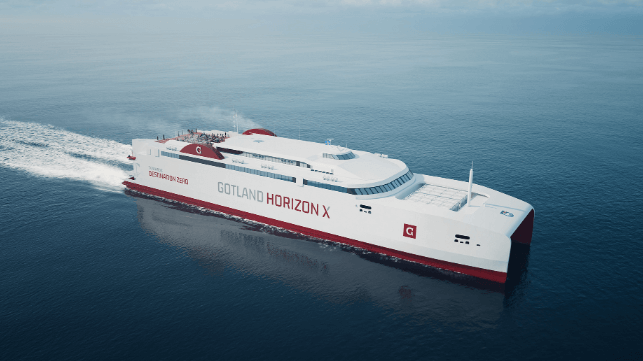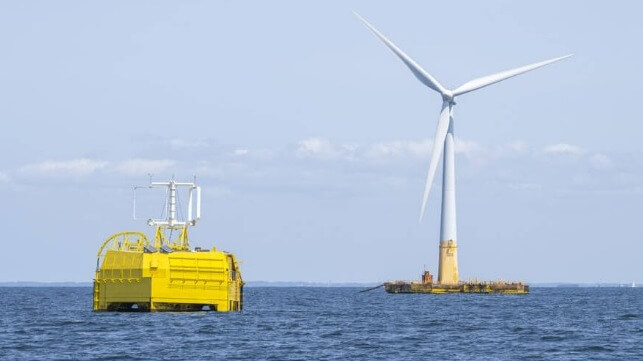Two New Partnerships Show Promise of Hydrogen Power in Europe

Two newly-announced projects add to a growing list of hydrogen-propulsion partnerships in Northern Europe. In Boden, Sweden and Duisburg, Germany, H2 suppliers and shipping companies have announced additional initiatives to bring this green fuel to the maritime market.
Swedish ferry operator Gotland Company announced Monday that it has reached an offtake agreement with hydrogen producer H2 Green Steel (H2GS). H2GS is the developer of a massive electrolyzer plant in Boden, a town in northern Sweden. The 700 MW plant will be among the largest in the world, and it will primarily supply a carbon-neutral steel mill.
Leveraging H2GS' experience in green H2 project development, the two companies are conducting a feasibility study to evaluate how to supply green H2 to power Gotland's future fleet. The ferry operator is currently developing two newbuilds designed to run on hydrogen, with an objective of having at least one ship operational by 2030. About 20,000 tonnes of hydrogen per year will be required to operate the company's route between the island of Gotland and the mainland.
"Collaborating with Gotland Company signifies expanding our competence in large scale hydrogen production beyond iron and steel. Joining forces with a Swedish partner sharing our passion for climate change matters and acting as the front runner to reduce emissions in the important ecosystem in the waters around Sweden, naturally feels especially strong and relevant," said Kajsa Ryttberg-Wallgren, Head of Hydrogen Business at H2 Green Steel.
The scope of the feasibility study includes the evaluation of infrastructure required to produce and transport the hydrogen for Gotland's operations. About 30 MW of electrolyzer capacity will be required, a small fraction of H2GS' total installed base.
Inland hydrogen power
Meanwhile, in the inland hub of Duisburg, Germany, port operator Duisport is in talks with H2 producer Lhyfe on the possibility of building a midsize green hydrogen production plant.
The proposal envisions a 20 MW electrolyzer complex located in Duisburg-Hochfeld's outer harbor, a few miles to the south of the main terminal area on the Rhine. This site currently handles coal, and the transformation would be pragmatic as well as symbolic: coal volumes are in decline.
Three local businesses have declared an intent to offtake H2 from the plant if it is built, including the future Duisburg Gateway Terminal, a carbon neutral container facility that will be built on the site of a former coal pier. Hydrogen is an integral part of the new container terminal's development plan, and its success is key for Duisport's transition away from coal cargoes.
All that is needed is a better grid connection to carry enough green electricity to the development site, and two utilities have agreed to take care of the power supply.
Duisport and Lhyfe have announced the launch of a feasibility study for the project, and it could be in operation as early as 2025.
"The construction of the first large-scale electrolyser in the Port of Duisburg would be a milestone on the way to decarbonising the domestic economy and industry," said Duisport CEO Markus Bangen. "At the same time, we are fulfilling our promise not only to build the largest container terminal in the European hinterland with the Duisburg Gateway Terminal, but also to operate it in a completely climate-neutral manner."
Lhyfe Produces First Green Hydrogen from Floating Offshore Platform

French renewable energy company Lhyfe reports that its pilot project Sealhyfe has produced the first kilos of green hydrogen from the first offshore hydrogen production platform. Sealhyfe is now connected to the subsea hub off Le Croisic, France in the Atlantic powered by a floating wind turbine, designed to demonstrate the potential and provide critical experience as the company works to scale up to large-scale offshore green hydrogen production.
The pilot hydrogen production platform was towed to the test site just over 12 miles offshore on May 19 to begin the second phase of its testing. It was then connected to the subsea hub at the SEM-REV offshore testing site using a dedicated umbilical cable that was specially designed for the hydrogen application. The hub is linked with a wind turbine, FLOATGEN, a 2 MW floating turbine engineered and operated by BW Ideol.
The platform began producing its first kilos of offshore hydrogen as of June 20, marking what Lhyfe is calling “a decisive milestone for the future of the sector.” It is the first of several projects that seeks to use power generated from offshore wind farms to develop a supply of green hydrogen that can be used as a decarbonizing fuel for industrial applications, including possibly in the maritime sector.
In launching the world’s first offshore hydrogen production pilot, Lhyfe says it wanted to prove the technical feasibility of such a project and acquire the operational experience needed to quickly scale up. Lhyfe and its partners designed, built and assembled all the technology necessary for producing hydrogen offshore, including the 1 MW electrolyzer supplied by Plug, in just 16 months. The Sealhyfe platform, which is less than 200 sq. meters in area, is capable of producing up to 400 kilograms of hydrogen a day.
From September 2022 to May 2023, Sealhyfe was moored at the Quai des Frégates, in the Port of Saint-Nazaire, France for a series of start-up tests. This included benchmarking the platform to provide comparison data for the second phase trial offshore. Systems were also optimized including the development of the software and algorithm building blocks necessary to manage the site remotely.
The platform will now replicate the previous tests of producing hydrogen offshore, under the toughest conditions. The company says it voluntarily chose to confront Sealhyfe with the toughest conditions offshore to test operations under real conditions. The floating platform was re-engineered to stabilize the production unit at sea.
Lhyfe is also preparing to move to the next stage of the demonstrations working with a consortium of nine partners to proceed to a large-scale project (10 MW) that will be able to produce up to four tonnes a day of green hydrogen at sea. The concept calls for exporting the hydrogen ashore by pipeline, and then compressed and delivered to commercial customers. Known as Project Hope, Lhyfe and its partners have been selected by the European Commission under the European Clean Hydrogen Partnership and are being awarded a €20 million grant as part of the goal to gear up to commercial scale.
Through these two pioneering projects in offshore hydrogen production, Lhyfe aims to validate industrial solutions for the production of green hydrogen. Their goal is to contribute to achieving the target set by the European Commission as part of the REPowerEU plan which calls for 10 million tonnes of clean hydrogen produced in the European Union by 2030.
No comments:
Post a Comment